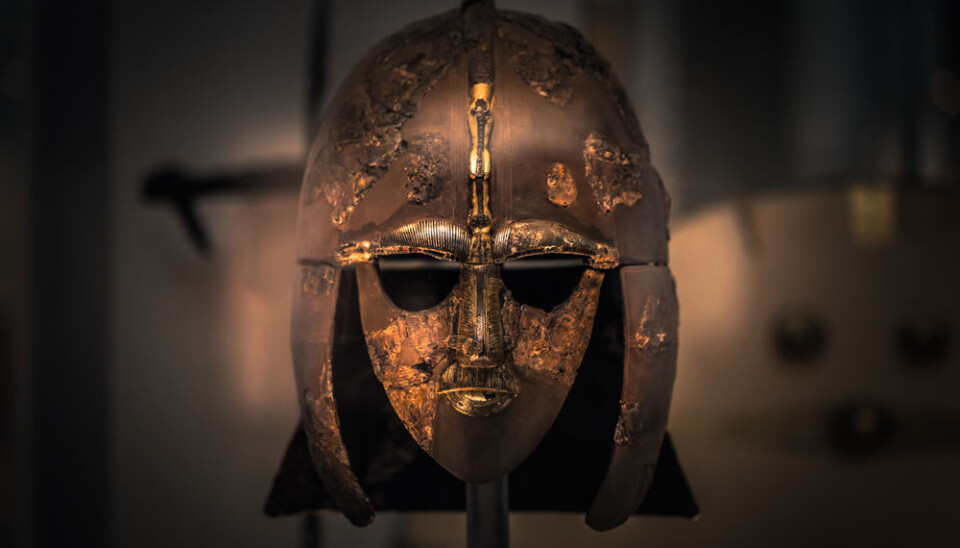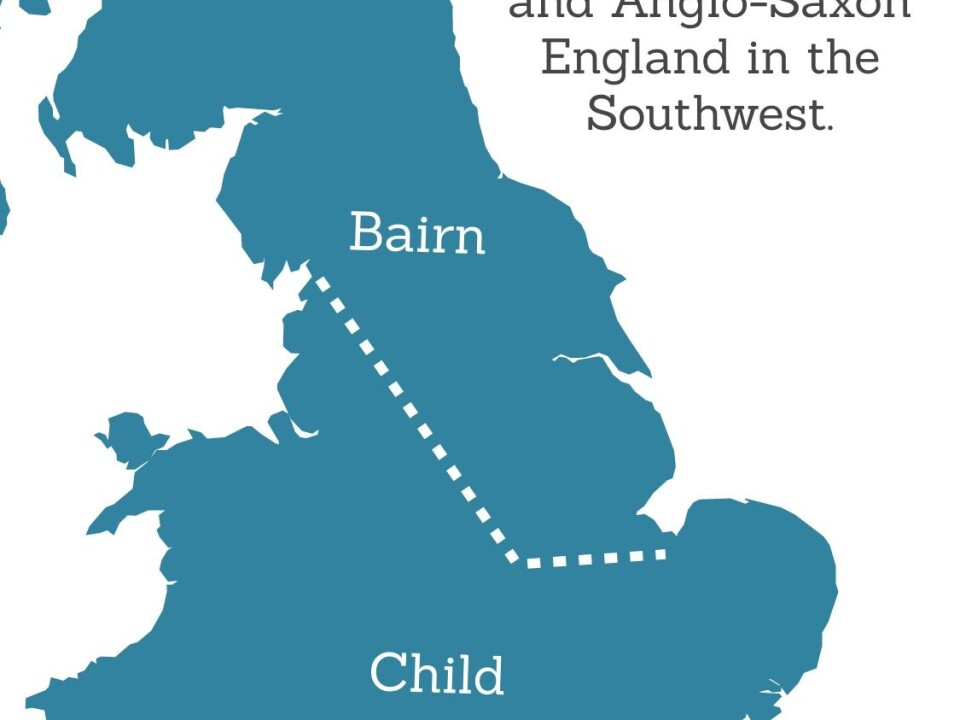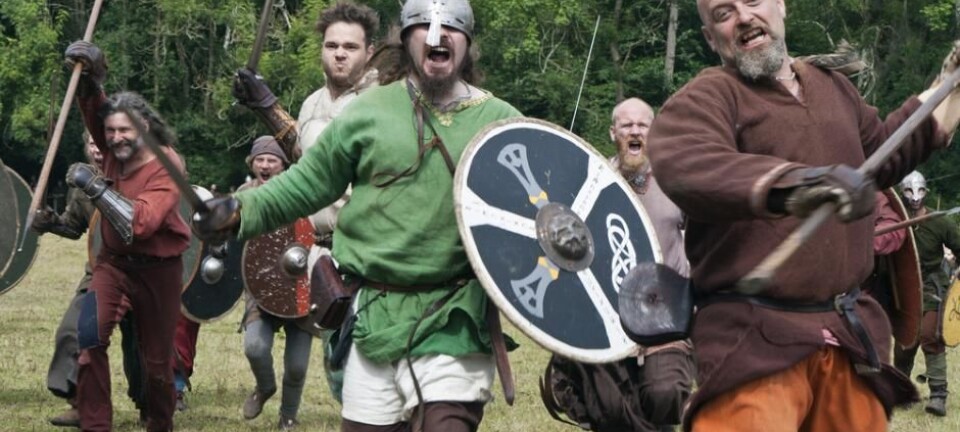
The Anglo-Saxons were worse than the Vikings
Linguistically, the Anglo-Saxons practically eradicated the native Britons. The question is: was it ethnic cleansing?
The Vikings invaded England in the 9th and 10th centuries. They plundered, raped and burned towns to the ground. Or at least, this is the story we know from school and popular culture.
Nevertheless, the reported plundering and ethnic cleansing are probably overrated. The Vikings simply had worse ‘press coverage’ by frustrated English monks, who bemoaned their attacks.
In recent decades, ground breaking research in DNA, archaeology, history, and linguistics provide nuance to these written records. And together they provide a much clearer picture.
They indicate that the Vikings were not the worst invaders to land on English shores at that time. That title goes to the Anglo-Saxons, 400 years earlier!

The Anglo-Saxons came from Jutland in Denmark, Northern Germany, the Netherlands, and Friesland, and subjugated the Romanized Britons.
This means, if the Viking Age is defined by numerous migrations and piracy (according to most scholars, Viking means ‘pirate’), the Viking Age should start earlier than 793 CE. It should really start already around 400 CE.
Here, I outline the various sources that indicate a much more systematic colonisation that started with the Anglo-Saxons, and how recent research when viewed in its entirety, gives us a much clearer understanding of the impact that the Anglo-Saxons had before the Vikings arrived.
Read More: The Viking Age should be called the Steel Age
The Anglo-Saxons eradicated Celtic languages in England
One support for this contention is the impact or rather the lack of impact that the Viking Old Norse had on contemporary Old English language of the Anglo Saxons in the 9th and 10th centuries. This should be compared to the absence of Celtic language in England in the 5th and 6th centuries after the Anglo-Saxons had arrived.
In the 5th and 6th centuries, the Old English wiped out the earlier Celtic language in a similar way that modern English eradicated the language of the Native Americans in U.S. in the 19th and 20th centuries.
This is clear in the almost non-existent impact that Native American words have on the English spoken today in the U.S. Modern American English has retained around 40 Native American words. Similarly, only a dozen Celtic words made it into the Old English of the Anglo Saxons.
So, did the Anglo Saxons have the same sort of impact on the Britons that 19th century Europeans had on Native Americans? And are we looking at ethnic cleansing in the 5th - 8th centuries?
Read More: Vikings versus Iron Age: Who made the best swords?
An Anglo-Saxon sells a horse to a Viking
If the Anglo-Saxons eradicated the Celtic language, the Viking’s impact was significantly less. Linguists do see some influence from the Old Norse of the Vikings in the Old English language. But it doesn’t come close to the eradication of Celtic by the Anglo-Saxons.
Old Norse did not eradicate the Old English language; Old English was simplified or pidginised because the Anglo Saxons and the Vikings were able to coexist for a time.
An example could be somewhere in Eastern England in the 9th century where an Anglo-Saxon met a Norseman.
The Anglo-Saxon wants to sell the Norseman a horse to pull a wagon. In modern English he’d have said the equivalent of “I’ll sell you that horse that drags my wagon.” In Old English it would have sounded like this: “Ic selle the that hors the draegeth minne waegn.”
The Norseman on the other hand would say “Ek mun selja ther hrossit er dregr vagn mine.”
One says “waegn” where other says "vagn,” meaning wagon.
One says “hors” for horse, and “draegeth” for drag, while the other says “hros” and ”dregr.”
The point is that there are differences but they would have understood each other. What is lost in translation are the grammatical elements.
For example, it would be difficult for the Norseman to know if the Anglo-Saxon was speaking about one or two horses, as the Anglo-Saxon says “that hors” for one horse, but for two horses he says “tha hors.”
Therefore, according to some linguists, English was simplified because of the meeting between two closely related languages. The plurals slowly became “-s.” ”Stone,” which in Old English is “stan” in singular, and “stanas” in the plural developed to “stone” and ”stones.” Hors in the singular became “horses” in the plural.
Read More: Why Danish Vikings moved to England
Anglo-Saxons caused more change than the Vikings
The same process that changed the language spoken in Britain 1,200 years ago also led to of the pidginisation of languages in the old English and French colonies of Africa, the Caribbean, and the Pacific, 500 years ago.
The language simplified, so one could ‘do business’ and communicate when people and languages met. They did not want to be cheated in the horse trade, so to speak.
Numerous archaeological finds of settlements and graves in England suggest that many Scandinavians settled in the Eastern part of England, in what they called Danelaw and in parts of Scotland.
On the other hand, the Old English of the 9th century was not assimilated into Old Norse, unlike the earlier irradiation of Celtic by the first Anglo Saxon conquests.
Put simply, the impact of Viking immigration was not as massive as the arrival of the Anglo-Saxons in the 5th century. And this is now backed up by a large-scale DNA analyses of the modern British.
And for those of you who read Danish, you can read more about this evidence in my recent article published in SKALK.
Read More: New study reignites debate over Viking settlements in England
Anglo-Saxon apartheid and Scandinavian multi-ethnic culture
In fact, some scholars have suggested that the Anglo-Saxons practiced a sort of apartheid against the local Celtic-speaking people between the 5th and 9th centuries, where they probably lived apart, or only had limited interaction.
As we saw in South Africa from 1948 until Nelson Mandela came to power in 1994, apartheid was, however, hard to enforce long-term.
Ethnic cleansing by the Anglo-Saxons is a likely alternative scenario, as suggested by the fact that Celtic culture and language did not survive outside of Wales, Scotland, and Ireland.
Additionally, the Romano-British were less well organised and lived in a vacuum after the Romans left Britain in the 5th century, whereas the later Anglo Saxon kingdoms of the 9th century were better organised. Thus, Anglo-Saxon England was harder to conquer in a similar way. The Vikings most likely married into Anglo-Saxon families over time, yes maybe the children of the Scandinavians were raised by Anglo-Saxon servants, as was the case among white American children in the southern states, where African slaves took care of white children.
In the U.S., white children often adopted words from African Americans, before they were sent to boarding schools in the North to learn ‘proper’ English.
Whether poor servants played a similar role among the Vikings in Danelaw England we do not know. But the lack of boarding schools for re-education back home could explain why Old Norse did not gain too much ground!
Additionally, by intermarrying there was no way to maintain the Old Norse language in England.
However, some linguists suggest that if Scandinavians and Anglo-Saxons had not met up and in that process modified each other’s languages, people in England today would speak something more similar to Frisian or Danish, depending on whether the Anglo-Saxons or Vikings had won the language clash.
Read More: What can linguistics tell us about the Vikings in England?
Place names indicate the presence of Scandinavians and Anglo-Saxons
Place names confirm the presence of Scandinavian and Anglo-Saxon settlements in England.
Anglo-Saxon place names end in -ham, like Clapham, -stowe like Hawkstowe, and -ton like Brighton. The place names of the Scandinavians end in -by like Grimsby and Derby.
The word ’by’ is in Sweden still a small hamlet as opposed to a ‘stad’, which is a city. -wick is also seen as of Scandinavian origin like in Swainswick, and -thorpe and -toft.
The last names suggest that the Scandinavians initially founded a number of field systems, which indicate that they settled on land that was more marginal. Later the fight for land increased.
Read More: Archaeologists and historians clash with geneticists over Viking study
King Alfred stopped the advance of the Vikings
But all of this is not to underestimate the immediate threat that the Viking’s posed to life in 9th century England.
In CE 878 the Viking invasions became so dire that the Anglo-Saxons were close to being overrun by the Scandinavians, just as their Anglo-Saxon ancestors had besieged the Britons 400 years earlier.
King Alfred of Wessex was forced into hiding in a bog in Somerset with a small group of men, and many omens suggested that the future England was going to be inhabited by Old Norse-speaking peoples.
However, Alfred succeeded in gathering an army from Somerset, Wiltshire, and Hampshire. He made a surprise attack on the Danes at the battle of Ethandune, a battle that to this day is commemorated by a large white horse carved into the hill.
After the battle, Alfred settled the dispute by the so-called Treaty of Wedmore. He forced the Danes to withdraw their army from Wessex. In addition, their leader, Guthrom, was christened.
His victory saved Wessex and perhaps even the English language.
Alfred drew a line across the country, behind which he settled to the South, and the Danes settled towards the Northeast. Everything behind the frontier was the Danelaw.
This frontier ran northwest along the old Roman road from London to Chester, west of Rugby, a Nordic place name, and south of present day Liverpool. Dialects still spoken throughout England today point to the dominance of a Danish speaking population east of this line.
Read More: English mass grave contains remains of Viking Great Army
Alfred’s policies of identity kept the Danish language at bay
Alfred was now much more alert and he mobilised the English against the Danes. He also rebuilt a number of monasteries and schools.
He started using English instead of Latin as a basis for further education, and he initiated the first translation of Bede’s ‘The History of the English.’
He knew that without a history, the English had no identity against the Danes. Thus, he saved the English language against further pidginisation.
Read More: Danish Viking fortresses were designed to fend off other Vikings
The Vikings had a bad (English) press
Even though the Christian chroniclers complained about the Viking invasions and written and archaeological sources confirm that the Vikings came in large numbers, with modern eyes and evidence, it seems that the Viking invasion was not as massive as the Anglo-Saxon invasion, 400 years earlier.
First, they did not take over the entire country of England, neither linguistically, materially, nor genetically.
Second, all analyses show that the present population of the East of England has more in common with the peoples on the North Sea coast (Northern Germany and Netherlands), one of the places of origin of the Anglo-Saxons, than they do with the present day population of Scandinavia. This is supported by all sources, including DNA.
Finally, the same study suggests that the flow of Anglo-Saxon immigration must have been so massive that they came to consist of up to 40 per cent of the population in England at the time. The Vikings did not come close to that. And where the earlier Anglo-Saxons apparently did not mix with the native Britons, the Vikings did exactly that with the now Anglo-Saxon English.
By these measures, the Vikings were not as bad as the name and the written sources suggest.
If the Viking Age is to be defined as the period when piracy, migration, and ethnic cleansing, was predominant, the period should start much earlier.
Of course, there is more to the Viking Age than piracy and pillaging. But this is another story for another day.
---------------
Read this article in Danish at ForskerZonen, part of Videnskab.dk
Translated by: Catherine Jex
Scientific links
- Mads Ravn. Angelsakserne i England. Skalk 2018 (Danish article: The Anglo-Saxons in England)
- Mads Ravn, Death Ritual and Germanic Social Structure, Oxford 2003. PhD Thesis.
- Stephen Leslie et al, The fine-scale genetic structure of the British population, i: Nature, vol 519 (2015), pp. 309-314.









